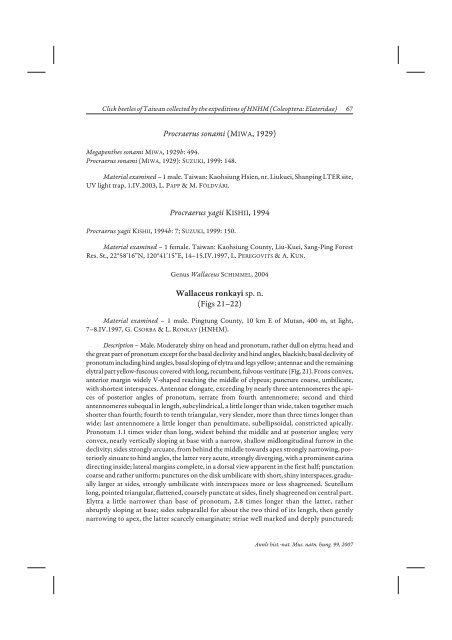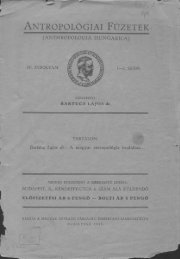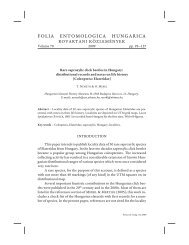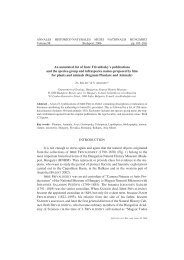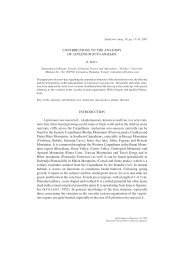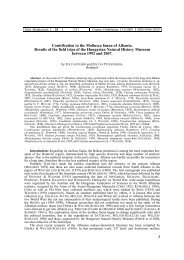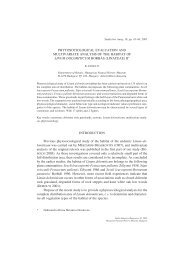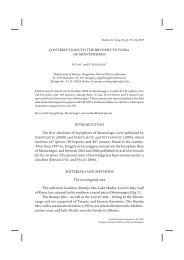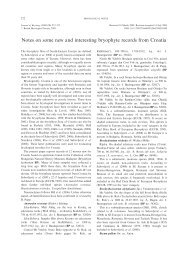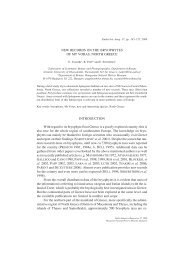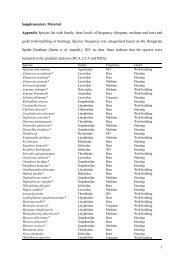Create successful ePaper yourself
Turn your PDF publications into a flip-book with our unique Google optimized e-Paper software.
Click beetles of Taiwan collected by the expeditions of HNHM (Coleoptera: Elateridae) 67Procraerus sonami (MIWA, 1929)Megapenthes sonami MIWA, 1929b: 494.Procraerus sonami (MIWA, 1929): SUZUKI, 1999: 148.Material exam<strong>in</strong>ed – 1 male. Taiwan: Kaohsiung Hsien, nr. Liukuei, Shanp<strong>in</strong>g LTER site,UV light trap, 1.IV.2003, L. PAPP & M. FÖLDVÁRI.Procraerus yagii KISHII, 1994Procraerus yagii KISHII, 1994b: 7; SUZUKI, 1999: 150.Material exam<strong>in</strong>ed – 1 female. Taiwan: Kaohsiung County, Liu-Kuei, Sang-P<strong>in</strong>g ForestRes. St., 22°58’16”N, 120°41’15”E, 14–15.IV.1997, L. PEREGOVITS & A. KUN.Genus Wallaceus SCHIMMEL, 2004Wallaceus ronkayi sp. n.(Figs 21–22)Material exam<strong>in</strong>ed – 1 male. P<strong>in</strong>gtung County, 10 km E of Mutan, 400 m, at light,7–8.IV.1997, G. CSORBA & L. RONKAY (HNHM).Description – Male. Moderately sh<strong>in</strong>y on head and pronotum, rather dull on elytra; head andthe great part of pronotum except for the basal declivity and h<strong>in</strong>d angles, blackish; basal declivity ofpronotum <strong>in</strong>clud<strong>in</strong>g h<strong>in</strong>d angles, basal slop<strong>in</strong>g of elytra and legs yellow; antennae and the rema<strong>in</strong><strong>in</strong>gelytral part yellow-fuscous; covered with long, recumbent, fulvous vestiture (Fig. 21). Frons convex,anterior marg<strong>in</strong> widely V-shaped reach<strong>in</strong>g the middle of clypeus; puncture coarse, umbilicate,with shortest <strong>in</strong>terspaces. Antennae elongate, exceed<strong>in</strong>g by nearly three antennomeres the apicesof posterior angles of pronotum, serrate from fourth antennomere; second and thirdantennomeres subequal <strong>in</strong> length, subcyl<strong>in</strong>drical, a little longer than wide, taken together muchshorter than fourth; fourth to tenth triangular, very slender, more than three times longer thanwide; last antennomere a little longer than penultimate, subellipsoidal, constricted apically.Pronotum 1.1 times wider than long, widest beh<strong>in</strong>d the middle and at posterior angles; veryconvex, nearly vertically slop<strong>in</strong>g at base with a narrow, shallow midlongitud<strong>in</strong>al furrow <strong>in</strong> thedeclivity; sides strongly arcuate, from beh<strong>in</strong>d the middle towards apex strongly narrow<strong>in</strong>g, posteriorlys<strong>in</strong>uate to h<strong>in</strong>d angles, the latter very acute, strongly diverg<strong>in</strong>g, with a prom<strong>in</strong>ent car<strong>in</strong>adirect<strong>in</strong>g <strong>in</strong>side; lateral marg<strong>in</strong>s complete, <strong>in</strong> a dorsal view apparent <strong>in</strong> the first half; punctationcoarse and rather uniform; punctures on the disk umbilicate with short, sh<strong>in</strong>y <strong>in</strong>terspaces, graduallylarger at sides, strongly umbilicate with <strong>in</strong>terspaces more or less shagreened. Scutellumlong, po<strong>in</strong>ted triangular, flattened, coarsely punctate at sides, f<strong>in</strong>ely shagreened on central part.Elytra a little narrower than base of pronotum, 2.8 times longer than the latter, ratherabruptly slop<strong>in</strong>g at base; sides subparallel for about the two third of its length, then gentlynarrow<strong>in</strong>g to apex, the latter scarcely emarg<strong>in</strong>ate; striae well marked and deeply punctured;Annls hist.-nat. Mus. natn. hung. 99, 2007


